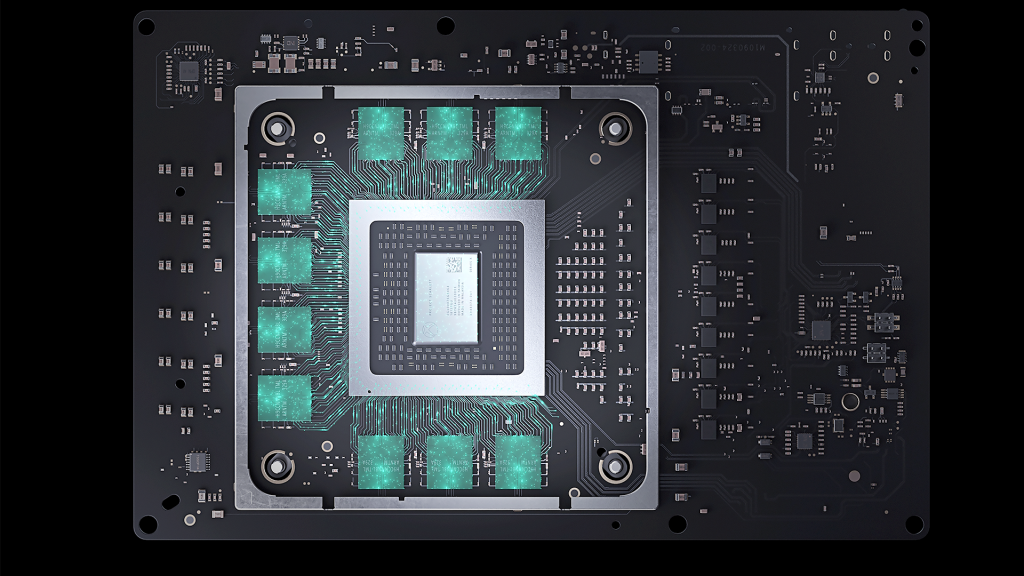Back when the Xbox One X was making its way on to the market, the folks at Digital Foundry were given an early look at the specs and capabilities of Microsoft's mid-gen refresh system. Now as we head towards the launch of Xbox Series X, history is repeating itself, with the DF team getting an in-depth look at the upcoming console, how its built, the full specifications and just what that hardware can do.
The CPU found inside the Xbox Series X is a custom ‘Zen 2' processor with eight cores running at 3.8GHz, although if Simultaneous Multi-Threading (SMT) is enabled, then CPU clock speed dips down to 3.6GHz. Meanwhile, the GPU is utilising RDNA 2 architecture, with 16GB of GDDR6, 52 Compute Units and a 1.8GHz clock speed, which is a 56 percent frequency boost over the GCN-based GPU found in the Xbox One X. The Project Scarlett System-on-Chip is fabricated using the TSMC 7nm Enhanced process, bringing the console up to the cutting edge of current hardware tech. In all, the console boasts just over 12 TFLOPS of compute performance.
Microsoft has also packed in a 1TB custom NVMe SSD, with IO throughput measuring in at 2.4GB/s (raw) and 4.8GB/s for compressed data. This is a huge bump over the Xbox One S and One X, which ran on HDDs with 120MB/s if throughput.
For performance targets, Microsoft is aiming to deliver 4K/60 gaming on the Series X with the option to run games at up to 120 frames per second if developers choose to lower the resolution in favour of frame rates. Meanwhile, the Xbox One X was primarily a 4K/30 machine with some titles being able to deliver 60 frames per second. At least one benchmark showed the Xbox Series X getting similar performance to an RTX 2080 while running Gears 5. This is just an early indication of performance, but it is a promising point to get across.
The jump to RDNA 2 graphics architecture also means support for DirectX Raytracing, using RT acceleration cores to enable more realistic lighting effects in games. Raytracing on the Xbox Series X is offloaded onto dedicated hardware, which can run in parallel to the main CPU and GPU to save on performance.
That does not mean that these additional lighting calculations won't cause performance dips, but so far, two games in particular are handling the job well. Minecraft RTX was announced last year and that ray-traced version of the game is set to come to the next-gen console too. Aside from that, The Coalition is enabling ray-traced shadows screen-space global illumination in Gears 5, the new ray-traced version is only a few weeks old at this point but so far, it is on track to be available on Xbox Series X at launch.
Now lets talk a bit more about the jump to SSD storage and the advantages it brings. PCs have been running Solid State Drives for many years now, bringing performance benefits to load times and even reducing some performance issues like hitching or pop-in, so what makes the console jump to SSDs special?
It all comes down to custom architecture. The Xbox Series X uses a custom NVMe SSD that looks and slots into the console more like an old memory card would. It consumes just 3.8 watts of power and is tuned to deliver consistent performance regardless of heat coming from other components in the chassis.
What this means is that developers have guaranteed 2.4GB/s of throughput to work with and Microsoft has developed a way to use the SSD to augment memory called the ‘Velocity Architecture'. In conjunction with the SSD, Microsoft has a 6GB/s decompression block, dedicated hardware that offloads data decompression from the CPU and enables instant access to game files tucked away on the SSD while saving CPU performance for other tasks.
Microsoft is working on a number of enhancements for first-party titles for Xbox Series X, including the likes of Gears 5, Halo 5, Minecraft and more as the backwards compatible team aims to really push things forward. Microsoft isn't revealing a ton of details on games yet, that will come later over the summer, but so far, the next-gen plan is looking quite impressive.
Discuss on our Facebook page, HERE.
KitGuru Says: The Xbox Series X is sounding much more impressive than we initially gave it credit for. Early indications show a very promising, but also very expensive machine. Now we'll just have to wait to see more games in action utilising all of this cutting-edge tech.
 KitGuru KitGuru.net – Tech News | Hardware News | Hardware Reviews | IOS | Mobile | Gaming | Graphics Cards
KitGuru KitGuru.net – Tech News | Hardware News | Hardware Reviews | IOS | Mobile | Gaming | Graphics Cards



